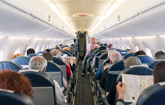DALLAS, Oct. 28, 2024 /PRNewswire/ -- Southwest Airlines Co. (NYSE: LUV) introduced a new bamboo cup for inflight cold beverages and a wood stir stick with the carrier's iconic Heart branding. Both the new cup and stir stick are part of the carrier's ongoing work toward its goal to eliminate, where feasible, single-use plastics from inflight service by 20301.
Southwest® expects the new items to reduce its inflight single-use plastics by more than 1.5 million pounds annually2. The airline continues to explore new sourcing initiatives to address single-use plastic packaging across inflight operations as part of its Nonstop to Net Zero strategy, a key tenet of which is Circularity3.
- Raising a Cold Cup: The new cold cup is made from 93% non-plastic materials, with a pulp blend consisting of 75% bamboo and 25% paper and a polyethylene (PE) lining. The U.S. Green Building Council considers bamboo a "rapidly renewable material"4 because it reaches maturity for harvest in three to five years.
- Creating Quite a Stir: The new stir stick is made from 100% FSC5-certified birch wood and maintains Southwest's iconic Heart branding.
- Cleaning up Napkins: In July 2024, Southwest transitioned to a paper overwrap for its napkins made from 100% post-consumer recycled materials, fully eliminating plastic from this service item. The overwrap is made from FSC or PEFC5-certified materials.
- Aloha, New Snack: In the coming months, Southwest will introduce a new select-a-snack offering on flights to and from Hawaii. This change is anticipated to decrease food waste and reduce single-use plastic packaging by at least 18,000 pounds annually.
Southwest analyzed the sustainability and environmental footprints of its inflight service items to identify opportunities for improvement. The carrier identified two of the largest sources of single-use plastics for inflight service: cups for cold beverages and stir sticks. Throughout 2024, Southwest developed an action plan to replace these items, which included robust testing among Customers and Employees.
"We expect our new bamboo cold cup, wood stir stick, and other initiatives to exceed our goal to reduce plastics from inflight service by 50% by weight by 2025, and we're excited to continue collaborating with our suppliers to work toward our goal of fully eliminating, where feasible, single-use plastics from inflight service by 20306," said Helen Giles, Managing Director of Environmental Sustainability at Southwest Airlines. "It's been a year of work since we announced our Nonstop to Net Zero strategy, including our initiatives to tackle single-use plastics in our inflight service. Today's announcement celebrates the hard work and dedication of many Teams across Southwest to meet these goals."
ABOUT SOUTHWEST AIRLINES CO.
Southwest Airlines Co. operates one of the world's most admired and awarded airlines, offering its one-of-a-kind value and Hospitality at 117 airports across 11 countries. Southwest took flight in 1971 to democratize the sky through friendly, reliable, and low-cost air travel and now carries more air travelers flying nonstop within the United States than any other airline7. Based in Dallas and famous for an Employee-first corporate Culture, Southwest maintains an unprecedented record of no involuntary furloughs or layoffs in its history. By empowering its more than 73,0008 People to deliver unparalleled Hospitality, the maverick airline cherishes a passionate loyalty among more than 137 million Customers carried in 2023. That formula for success brought industry-leading prosperity and 47 consecutive years9 of profitability for Southwest Shareholders (NYSE: LUV). Southwest leverages a unique legacy and mission to serve communities around the world including harnessing the power of its People and Purpose to put communities at the Heart of its success. Learn more by visiting Southwest.com/citizenship. As the airline with Heart, Southwest has set a goal to work toward achieving net zero carbon emissions by 205010. Southwest has also set near-term targets and a three-pillar strategy to achieve its environmental goals. Learn more by visiting Southwest.com/planet.
1 Includes plastics for Inflight service. Elimination goal is dependent on the availability of operationally and commercially feasible alternatives.
2 Based on cold cup and stir stick usage for calendar year 2023.
3 Circularity at Southwest means working toward reducing waste by maximizing the value of resources by keeping products and materials in circulation as long as possible, such as, for example, through reusing, recycling, and considering what happens to a product at the end of its lifecycle from the time that it is sourced start to source it.
4 The U.S. Green Building Council defines rapidly renewable building materials and products as those made from agricultural products that typically harvested within a 10-year or shorter cycle, including bamboo.
5 The Forest Stewardship Council (FSC) and the Programme for the Endorsement of Forest Certification (PEFC) are two non-profit organizations that certify forest products as sustainably sourced. Both organizations use independent third parties to verify that forests are managed responsibly.
6 The elimination goal depends on the availability of operationally and commercially feasible alternatives.
7 Based on U.S. Dept. of Transportation quarterly Airline Origin & Destination Survey since Q1 2021
8 Fulltime-equivalent active Employees
9 1973-2019 annual profitability
10 Our net zero by 2050 goal includes Scope 1, Scope 2, and Scope 3 Category 3 emissions only and excludes any emissions associated with non-fuel products and services, such as inflight service items.
SOURCE Southwest Airlines Co.






Share this article